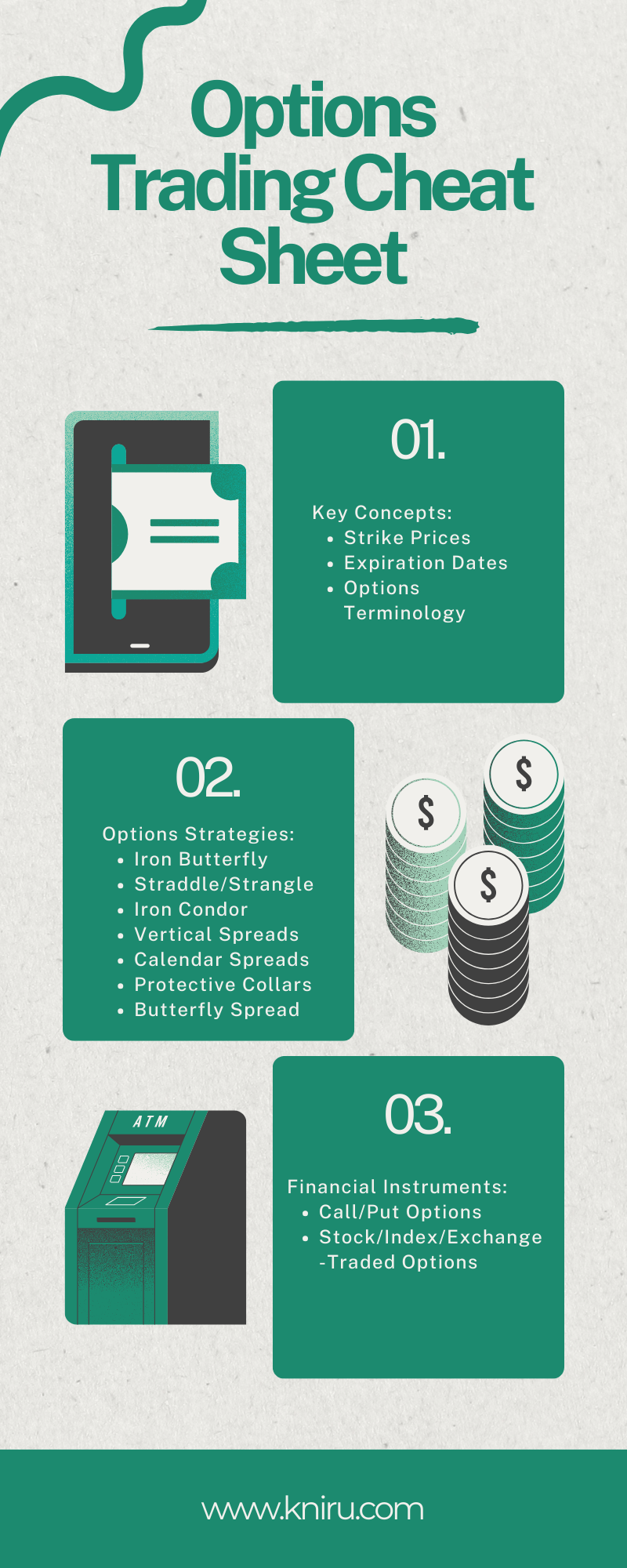Options Trading Cheat Sheet: Top Strategies and Success Metrics [Free]
Free Options Trading cheat sheet - Explore the essentials of options trading, from best practices and risk management to strategy selection, and unlock the potential for success in the trading world.
Abhinil Kumar
Author

Introduction
In the world of options trading, adopting best practices, implementing effective risk management, and cultivating patience and discipline are of utmost importance for successful outcomes. Options trading, although highly rewarding, can also be complex and risky. By following best practices, effectively managing risks, and practicing patience and discipline, traders can increase their chances of success and minimize potential losses.
Risk management also plays a critical role in options trading as it helps traders mitigate potential losses and protect their capital. By evaluating and assessing various risks associated with options trading, such as market volatility or changing economic conditions, traders can implement strategies that protect their investments. Effective risk management techniques include diversifying portfolios, setting stop-loss orders, and establishing risk-reward ratios.
Success in options trading also involves patience and discipline. Often, traders experience ups and downs in their trading journey, and it is important to remain patient during slower periods and disciplined in adhering to trading plans. Impulsive decisions or emotional reactions to market fluctuations can lead to poor outcomes. By maintaining a calm and rational mindset, traders can make well-informed decisions based on thorough analysis and logic.
Options Trading Cheat Sheet: A Brief Overview
Our Options Trading Cheat Sheet is an essential, easy-to-navigate guide designed to demystify the options market for traders at all levels. By summarizing key strategies, terms, and best practices into a concise reference, it empowers investors with the insights needed to make informed decisions, manage risks effectively, and potentially maximize profits. Whether you’re a beginner or an experienced trader, this cheat sheet simplifies complex information, helping you to understand and apply options trading concepts confidently.
The sheet outlines various options strategies, such as covered calls, protective puts, and more, along with their risk profiles and potential rewards. The cheat sheet also explains important options terminology, such as calls, puts, strike price, and expiration date, helping traders understand the language of options trading.
Strike Prices and Expiration Dates
Strike prices and expiration dates are two crucial components of an option contract. These elements dictate the terms at which an option can be exercised and the duration until the option expires.
The strike price refers to the predetermined price at which an option can be exercised. In other words, it is the price at which the buyer can buy or sell the underlying asset, depending on whether it is a call or put option. For a call option, the strike price is the price at which the buyer can purchase the underlying asset. Conversely, for a put option, the strike price is the price at which the buyer can sell the underlying asset. The strike price is usually set based on the current market price of the underlying asset and the type of option being traded.
On the other hand, the expiration date represents the date at which the option contract expires. It is the last day on which the option buyer can exercise their right to buy or sell the underlying asset. Expiration dates are predetermined by the option’s contract and typically occur on the third Friday of the contract month. After the expiration date, the option becomes worthless and any remaining value is lost.
Understanding expiration dates and their significance in options trading
Understanding expiration dates is crucial for anyone involved in options trading. An expiration date refers to the date on which an options contract becomes void and ceases to exist. In options trading, expiration dates play a significant role in determining the timeframe within which an options holder can exercise their rights. These dates are pre-set and are an essential element in the decision-making process for both options buyers and sellers. Expired options become worthless, which is why comprehending the significance of expiration dates is vital for effectively managing risk and maximizing potential profits in options trading. By gaining a solid understanding of expiration dates and their significance, options traders can navigate the market with greater confidence and make informed decisions to achieve their financial goals.

Options Trading Cheat Sheet
8 Popular options trading strategies to consider
Options trading strategies are techniques employed by traders to maximize their chances of success in the options market. Here are some key strategies:
- Iron Butterfly: This strategy involves buying a straddle (long call and long put) and selling a strangle (short call and short put) with the same expiration date. It profits from low volatility and limited movement in the underlying asset.
2. Straddle: This strategy involves buying a call and put option with the same strike price and expiration date. Traders use this in anticipation of high volatility, as it benefits from significant price swings in either direction.
3. Strangle: Similar to a straddle, this strategy involves buying out-of-the-money put and call options. The difference is that the strike prices are different. It aims to profit from significant price swings, but with somewhat less risk compared to a straddle.
4. Iron Condor: This strategy combines selling an out-of-the-money call spread and an out-of-the-money put spread. It profits from limited price movement within a specified range, known as the “condor’s wings.”
5. Vertical Spreads: These are options spreads involving the simultaneous purchase and sale of call or put options with different strike prices but the same expiration date. Bull call spreads, bear put spreads, and butterfly spreads are examples of this strategy.
6. Calendar Spreads: This strategy entails buying and selling options with the same strike price but different expiration dates. It benefits from time decay, as the near-term option will lose value faster than the longer-term option.
7. Protective Collars: This strategy involves holding a long position in an underlying asset while simultaneously buying a put option and selling a call option. It provides protection against downside risk and limits potential gains.
8. Butterfly Spread: This strategy combines buying and selling options with three different strike prices. It profits from limited price movement, with the maximum gain achieved when the underlying asset is near the middle strike price at expiration.
How to choose the right strategy for your trading goals
Choosing the right trading strategy is a crucial step towards achieving your trading goals. Whether you are a novice trader aiming for consistent returns or an experienced investor seeking rapid growth, the strategy you select will heavily influence your success. With countless strategies available, it’s essential to understand your personal trading goals, risk tolerance, and market conditions. In this section, we will explore the key considerations for choosing the right strategy for your trading goals, providing you with the necessary knowledge and insights to make an informed decision.
Price Range and Risk Management
The price range of an option refers to the range within which the underlying asset’s price is expected to move during the option’s lifespan. This range directly impacts the potential profit or loss that a trader may incur. For instance, if an option’s price range is narrow, it indicates that the underlying asset’s price is not expected to fluctuate significantly. As a result, the potential profit in such a scenario may be limited. On the other hand, a wider price range suggests higher volatility, opening up possibilities for greater potential profit or loss.
How to set a price range for your options trades?
Setting a price range for options trades involves a series of steps to ensure an accurate and optimal decision-making process.
1. Identify the underlying asset: Determine the specific asset (e.g., stocks, commodities, currencies) on which the options contract is based. This will serve as the foundation for pricing considerations.
2. Evaluate the current market conditions: Review the prevailing market factors such as supply and demand, volatility, interest rates, and economic indicators. These will impact the potential prices of the underlying asset and, consequently, the options prices.
3. Analyze historical price data: Study the historical price movements of the underlying asset to identify patterns and trends. This analysis can help anticipate potential future price ranges and assess the associated risks.
4. Research and understand the options chain: Examine the available options contracts for the chosen underlying asset, considering different expiration dates and strike prices. Determine the ones that align with your trading objectives and risk tolerance.
5. Assess implied volatility: Estimating future price volatility is crucial in setting a price range for options trades. Understand the implied volatility levels in the options market and evaluate how they align with your profit expectations and risk appetite.
6. Consider the time decay effect: Options contracts have expiration dates, after which their value rapidly decreases. Evaluate the impact of time decay on your chosen options contracts to set a realistic price range and determine the optimal time to execute your trades.
7. Factor in potential events or news: Anticipate any upcoming events such as earnings announcements, economic reports, or regulatory decisions that might influence the underlying asset’s price. Adjust your price range accordingly to account for any potential market reactions.
Implementing effective risk management techniques in options trading
Options trading involves the buying and selling of contracts that give traders the right, but not the obligation, to buy or sell an underlying asset at a specific price within a certain time frame. While options can offer significant profit potential, they also come with inherent risks that require careful management. This section will delve into some key risk management techniques that options traders can employ to minimize potential losses and maximize their chances of success in this complex and dynamic market.
Risk Tolerance and Financial Instruments
Risk tolerance refers to an individual’s capacity or willingness to bear uncertainty or volatility when it comes to making financial investments. It primarily revolves around an investor’s ability to absorb potential losses before panicking or making impulsive decisions. Understanding one’s risk tolerance is crucial in determining appropriate investment and option strategies and asset allocations.
In options trading, various financial instruments are used to manage risk and potentially profit from changes in the price of an underlying asset. Options are one such instrument. Options provide the holder the right, but not the obligation, to buy or sell an asset at a predetermined price within a specified period. They can be classified as either call options (providing the right to buy) or put options (providing the right to sell).
Other financial instruments used in options trading include futures contracts, which obligate the parties involved to buy or sell an asset at a predetermined price and date. Exchange-traded funds (ETFs) are investment funds traded on stock exchanges that can incorporate a wide range of securities, including options contracts. Finally, index funds provide exposure to a broad market index and can be used as a less volatile alternative to trading individual stocks.
Blending best practices, robust risk management, patience, and discipline are crucial components of successful options trading. Following best practices involves conducting thorough research, staying informed about market trends, and employing effective risk management strategies. Patience and discipline are vital to avoid making rash decisions based on short-term fluctuations and emotions. Practicing good risk management tool ensures that potential losses are controlled and minimized, while profits are protected and maximized.
How to assess your risk tolerance in options trading?
When assessing risk tolerance, several factors should be taken into consideration. One such factor is the individual’s financial situation. Evaluating one’s current financial position, including income, expenses, and savings, can help determine the level of risk they can afford to take. Another important consideration is investment goals, as they vary from person to person. For instance, someone close to retirement may prioritize capital preservation over high returns, while a younger investor may be more inclined to take on higher-risk trades for the potential of greater gains.Also Diversification, for example, involves spreading investments across different sectors or asset classes to reduce exposure to any single trade. This helps mitigate the impact of losses on the overall portfolio. Additionally, setting stop-loss orders can limit potential losses by automatically selling an option when it reaches a predetermined price. This risk management technique enables traders to exit a trade before losses become too significant, protecting their capital.
Different types of financial instruments available for options trading
Options trading involves the use of various financial instruments to speculate on the future movements of the financial markets. These instruments offer investors the opportunity to strategize and benefit from different market scenarios based on educated guesses about future market movements.
1. Call option - A call option gives the holder the right, but not the obligation, to buy an underlying asset at a predetermined price within a specific time period. Call options are used when traders expect the price of the underlying asset to rise.
2. Put option - A put option gives the holder the right, but not the obligation, to sell an underlying asset at a predetermined price within a specific time period. Put options are used when traders anticipate that the price of the underlying asset will decline.
In addition to call and put options, traders can also utilize other financial instruments such as stock options, index options, and exchange-traded options. These instruments enable investors to diversify their options portfolio and hedge against potential risks.
Conclusion
Incorporating the form of trading known as options into your trading repertoire can significantly enhance the strength of your trading strategy. By understanding the nuances of the trading calendar and effectively managing your trading queue, you are better equipped to navigate the complexities of the market. Familiarity with trading terminology, including price gaps and limited risks, further empowers traders to make informed decisions.
Options trading, with its intricate strategies and potential for high returns, demands a comprehensive grasp of its mechanisms. By mastering the art of risk management and staying attuned to the trading calendar’s key dates, traders can minimize losses while capitalizing on opportunities. The use of trading queues and a keen understanding of price gaps are essential for timing trades effectively and maximizing potential gains.


